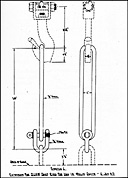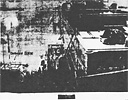MINIMUM DRIVER WEEKLY MAINTENANCE
REFER TO TM 9-802 & LUBRICATION ORDER #505 FOR DETAILS
DRAIN WATER FROM FUEL TANK & FILTER, & CHECK SYSTEM FOR LEAKS.
CHECK FUEL, OIL, & WATER - IN ENGINE, TIRE PUMP, AND SPARE CANS.
CHECK OIL LEVEL IN TRANSMISSION, MAIN & PROP.TRANS.CASES, WINCH WORM HSG.
OIL HAND AND FOOT THROTTLE, CHOKE, STARTER LINKAGE & 2 CUPS ON TIRE PUMP.
LUBRICATE CONTROLS FOR MAIN & PROPELLER TRANSFER CASES, BRAKES & CLUTCH.
LUBRICATE V-STRUT & BILGE PUMPS, CHECK DRAIN VALVES & PLUGS ALL TIGHT.
CHECK BATTERY WATER & CRANKCASE & CARB. AIR CLEANERS - CLEAN RADIATOR.
MAKE LAND TEST RUN. CHECK FOOT BRAKES AND COMPASS ADJUSTMENT.
CHECK IDLING SPEED FOR 500 R.P.M. CHECK FOR LOOSE MANIFOLD NUTS.
MAKE WATER TEST RUN. CHECK FOR LEAKS. CHECK OPERATION OF PUMPS.
CHECK FOR 2350 MINIMUM R.P.M. & NOT OVER 185° TEMPERATURE AT FULL THROTTLE.
CLEAN & DRAIN BILGES, LUBRICATE 3 "U" JOINTS THRU HOUSING DRAINS.
CHECK 4 BREATHER TUBES, 6 HOUSING SEALS & INTER-HOUSING DRAIN.
REPLACE PLUGS, CLOSE DRAIN VALVES. REMOVE ANY WATER IN PILLOW BLOCK,
DIFFERENTIALS AND FRONT AXLE "U" JOINTS - CHECK LUBRICANT LEVELS.
LUBRICATE V-STRUT, INTER-AXLE SHAFT (3), FRONT SPRINGS (6), DRAG LINK (2),
TIE ROD (2), TIRE INFLATION HUBS (6), BILGE PUMPS (2), STUFFING BOXES (2).
OIL OUTSIDE OF FRONT AXLE "U" JOINTS, CHECK OIL LEVEL IN AIR CLEANERS.
GREASE 3 WINCH POINTS - OIL & REWIND CABLE. OIL PUMP DRIVE CHAINS.
CLEAN & PAINT RUSTED PARTS. CLEAN & OIL OUTSIDE OF FRONT AXLE "U" JOINTS.
CHECK & STOW TOOLS & EQUIPMENT. CLOSE HATCHES. RIG CAB TARPAULIN.
|




































